change time MERCEDES-BENZ C-CLASS ESTATE 2007 Owners Manual
[x] Cancel search | Manufacturer: MERCEDES-BENZ, Model Year: 2007, Model line: C-CLASS ESTATE, Model: MERCEDES-BENZ C-CLASS ESTATE 2007Pages: 377, PDF Size: 6.19 MB
Page 4 of 377
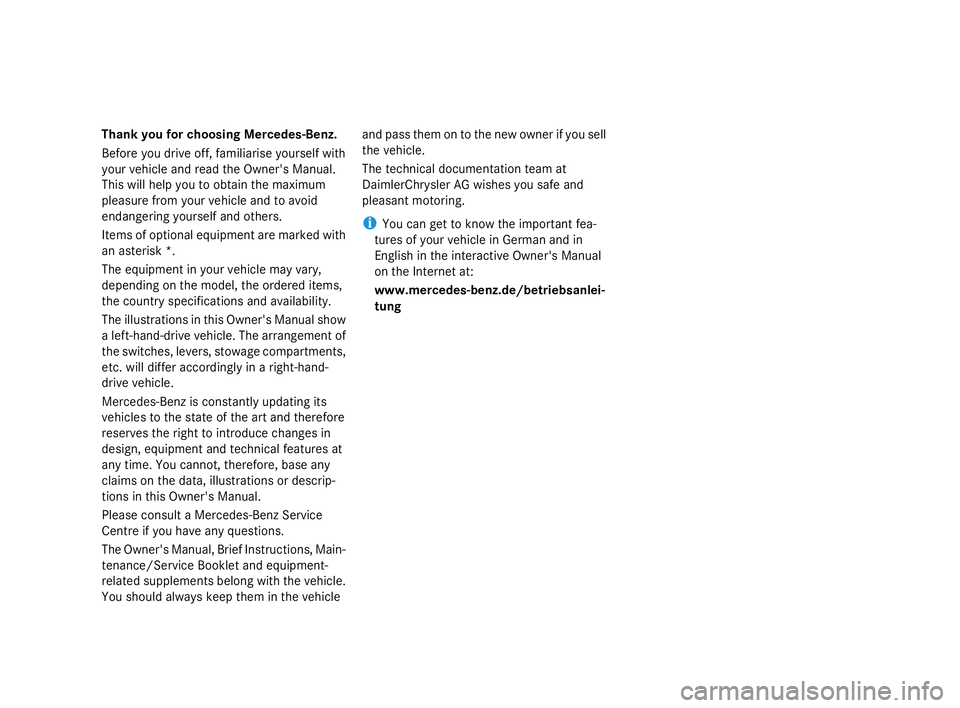
Thank you for choosing Mercedes-Benz.
Before you drive off, familiarise yourself with
your vehicle and read the Owner's Manual.
This will help you to obtain the maximu m
pleasure from your vehicle and to avoid
endangering yourself and others.
Items of optional equipment are marked with
an asterisk *.
The equipment in your vehicle may vary,
depending on the model, the ordered items ,
the country specifications and availability.
The illustrations in this Owner's Manual sho w
a left-hand-drive vehicle. The arrangement of
the switches, levers, stowage compartments ,
etc. will differ accordingly in a right-hand-
drive vehicle.
Mercedes-Benz is constantly updating its
vehicles to the state of the art and therefore
reserves the right to introduce changes in
design, equipment and technical features at
any time. You cannot, therefore, base any
claims on the data, illustrations or descrip-
tions in this Owner's Manual.
Please consult a Mercedes-Benz Service
Centre if you have any questions .
The Owner's Manual, Brief Instructions, Main-
tenance/Service Booklet and equipment-
related supplements belong with the vehicle.
You should always keep them in the vehicle and pass them on to the new owner if you sell
the vehicle.
The technical documentation team at
DaimlerChrysler AG wishes you safe and
pleasant motoring.
i
You can get to know the important fea-
tures of your vehicle in German and in
English in the interactive Owner's Manual
on the Internet at:
www.mercedes-benz.de/betriebsanlei-
tung
204_AKB; 2; 3, en-GB
mkalafa,
2007-06-26T23:11:51+02:00 - Seite
1
Page 20 of 377
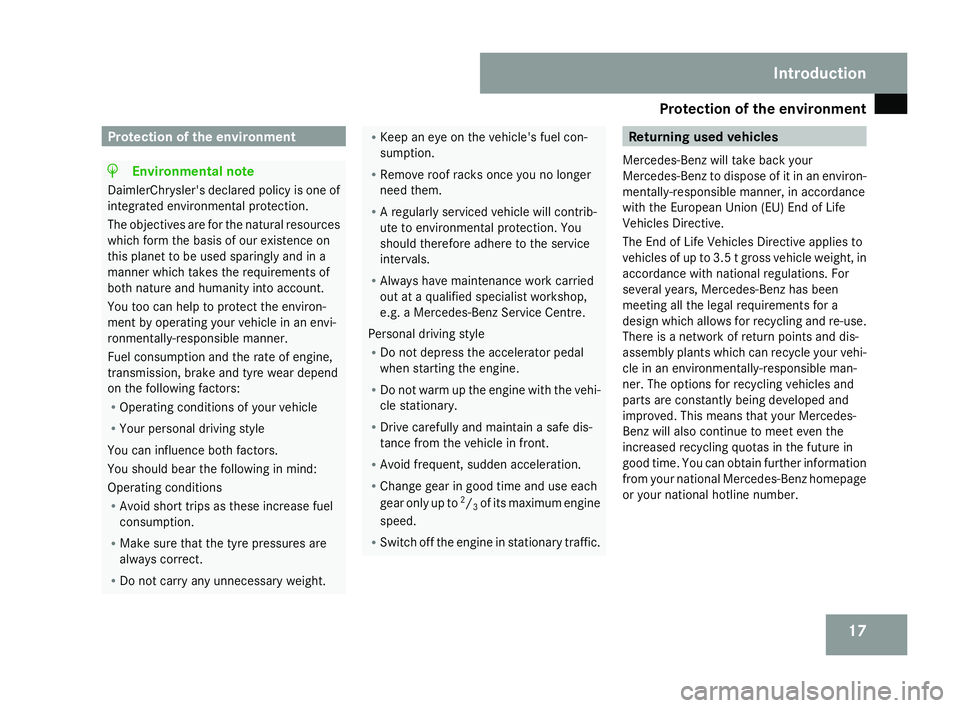
Protection of the environment
17Protection of the environment
H
Environmental not
e
DaimlerChrysler's declared policy is one of
integrated environmental protection.
The objectives are for the natural resource s
which form the basis of our existence on
this planet to be used sparingly and in a
manner which takes the requirements of
both nature and humanity into account.
You too can help to protect the environ-
ment by operating your vehicle in an envi-
ronmentally-responsible manner.
Fuel consumption and the rate of engine,
transmission, brake and tyre wear depend
on the following factors:
R Operating conditions of your vehicle
R Your personal driving style
You can influence both factors.
You should bear the following in mind:
Operating condition s
R Avoid short trips as these increase fuel
consumption.
R Make sure that the tyre pressures are
always correct.
R Do not carry any unnecessary weight. R
Keep an eye on the vehicle's fuel con-
sumption.
R Remove roof racks once you no longer
need them.
R A regularly serviced vehicle will contrib-
ute to environmental protection. Yo u
should therefore adhere to the service
intervals.
R Always have maintenance work carrie d
out at a qualified specialist workshop,
e.g. a Mercedes-Benz Service Centre.
Personal driving style
R Do not depress the accelerator peda l
when starting the engine.
R Do not warm up the engine with the vehi-
cle stationary.
R Drive carefully and maintain a safe dis-
tance from the vehicle in front.
R Avoid frequent, sudden acceleration.
R Change gear in good time and use eac h
gear only up to 2
/ 3of its maximum engine
speed.
R Switch off the engine in stationary traffic. Returning used vehicle
s
Mercedes-Benz will take back your
Mercedes-Benz to dispose of it in an environ-
mentally-responsible manner, in accordance
with the European Union (EU) End of Life
Vehicles Directive.
The End of Life Vehicles Directive applies to
vehicles of up to 3.5 t gross vehicle weight, in
accordance with national regulations. For
several years, Mercedes-Benz has been
meeting all the legal requirements for a
design which allows for recycling and re-use.
There is a network of return points and dis-
assembly plants which can recycle your vehi-
cle in an environmentally-responsible man-
ner. The options for recycling vehicles and
parts are constantly being developed and
improved. This means that your Mercedes-
Benz will also continue to meet even the
increased recycling quotas in the future in
good time. You can obtain further information
from your national Mercedes-Benz homepage
or your national hotline number. Introduction
204_AKB; 2; 3, en-GB
mkalafa,
2007-06-26T23:11:51+02:00 - Seite 17
Page 67 of 377
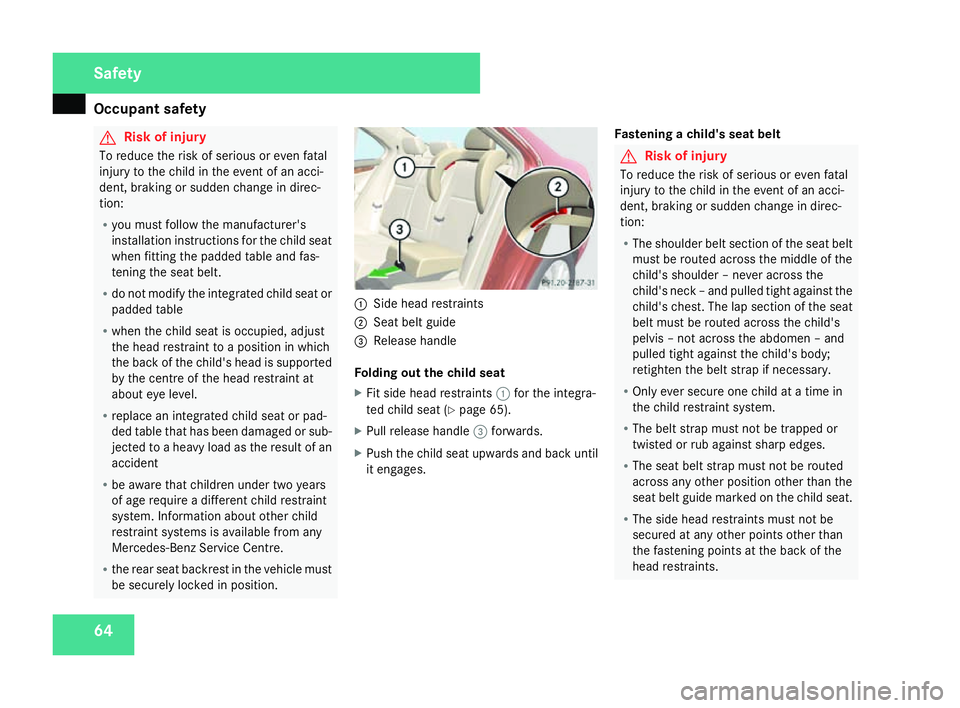
Occupant safet
y64 G
Risk of injury
To reduce the risk of serious or even fata l
injury to the child in the event of an acci-
dent, braking or sudden change in direc -
tion:
R you must follow the manufacturer' s
installation instructions for the child seat
when fitting the padded table and fas-
tening the seat belt.
R do not modify the integrated child seat or
padded table
R when the child seat is occupied, adjus t
the head restraint to a position in which
the back of the child's head is supporte d
by the centre of the head restraint at
about eye level.
R replace an integrated child seat or pad-
ded table that has been damaged or sub-
jected to a heavy load as the result of an
acciden t
R be aware that children under two years
of age require a different child restraint
system. Information about other child
restraint systems is available from any
Mercedes-Benz Service Centre.
R the rear seat backrest in the vehicle must
be securely locked in position. 1
Side head restraints
2 Seat belt guid e
3 Release handle
Folding out the child sea t
X Fit side head restraints 1for the integra -
ted child seat (Y page 65).
X Pull release handle 3forwards.
X Push the child seat upwards and back until
it engages. Fastening a child's seat belt G
Risk of injury
To reduce the risk of serious or even fata l
injury to the child in the event of an acci-
dent, braking or sudden change in direc -
tion:
R The shoulder belt section of the seat belt
must be routed across the middle of the
child's shoulder – never across the
child's neck – and pulled tight against the
child's chest. The lap section of the seat
belt must be routed across the child's
pelvis – not across the abdomen – and
pulled tight against the child's body;
retighten the belt strap if necessary.
R Only ever secure one child at a time in
the child restraint system.
R The belt strap must not be trapped or
twisted or rub against sharp edges.
R The seat belt strap must not be routed
across any other position other than the
seat belt guide marked on the child seat.
R The side head restraints must not be
secured at any other points other than
the fastening points at the back of the
head restraints. Safety
204_AKB; 2; 3, en-GB
mkalafa,
2007-06-26T23:11:51+02:00 - Seite 64
Page 79 of 377
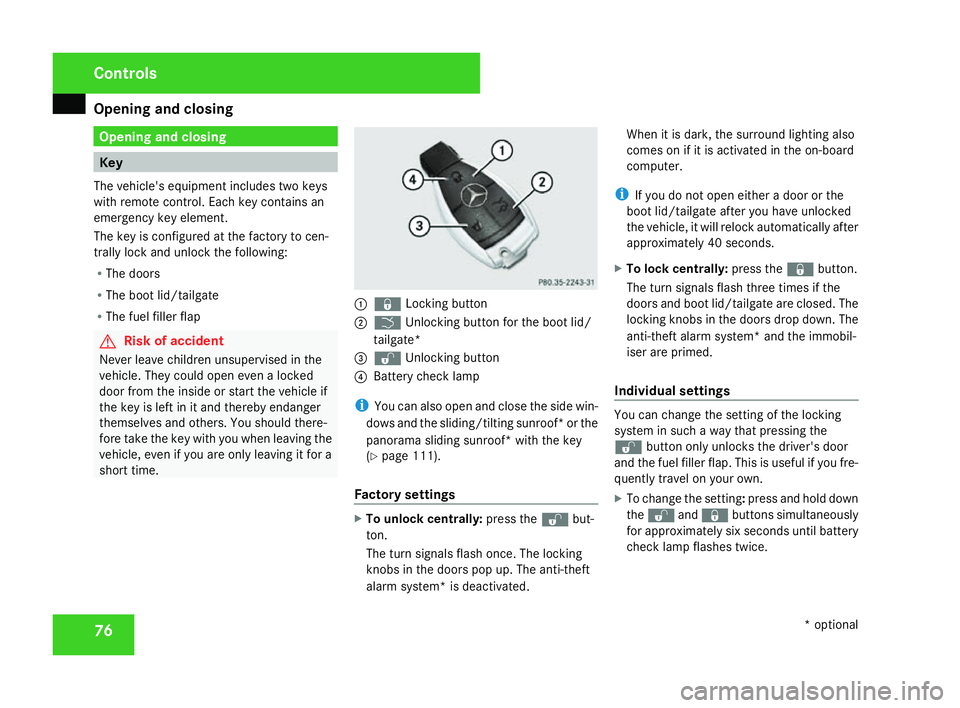
Opening and closing
76 Opening and closing
Key
The vehicle's equipment includes two keys
with remote control. Each key contains an
emergency key element .
The key is configured at the factory to cen-
trally lock and unlock the following:
R The doors
R The boot lid/tailgate
R The fuel filler flap G
Risk of accident
Never leave children unsupervised in the
vehicle. They could open even a locked
door from the inside or start the vehicle if
the key is left in it and thereby endanger
themselves and others. You should there -
fore take the key with you when leaving the
vehicle, even if you are only leaving it for a
short time. 1
j Locking button
2 i Unlocking button for the boot lid/
tailgate*
3 k Unlocking button
4 Battery check lamp
i You can also open and close the side win-
dows and the sliding/tilting sunroof* or the
panorama sliding sunroof* with the key
( Y page 111).
Factory settings X
To unlock centrally :press the kbut-
ton .
The turn signals flash once. The lockin g
knobs in the doors pop up. The anti-theft
alarm system* is deactivated .When it is dark, the surround lighting also
comes on if it is activated in the on-board
computer.
i If you do not open either a door or the
boot lid/tailgate after you have unlocked
the vehicle, it will relock automatically after
approximately 40 seconds.
X To lock centrally :press the jbutton.
The turn signals flash three times if the
doors and boot lid/tailgate are closed. The
locking knobs in the doors drop down. The
anti-theft alarm system* and the immobil-
iser are primed.
Individual settings You can change the setting of the locking
system in such a way that pressing the
k button only unlocks the driver's door
and the fuel filler flap. This is useful if you fre-
quently travel on your own.
X To change the setting: press and hold down
the k andj buttons simultaneously
for approximately six seconds until battery
check lamp flashes twice. Controls
* optional
204_AKB; 2; 3, en-GB
mkalafa,
2007-06-26T23:11:51+02:00 - Seite 76
Page 80 of 377
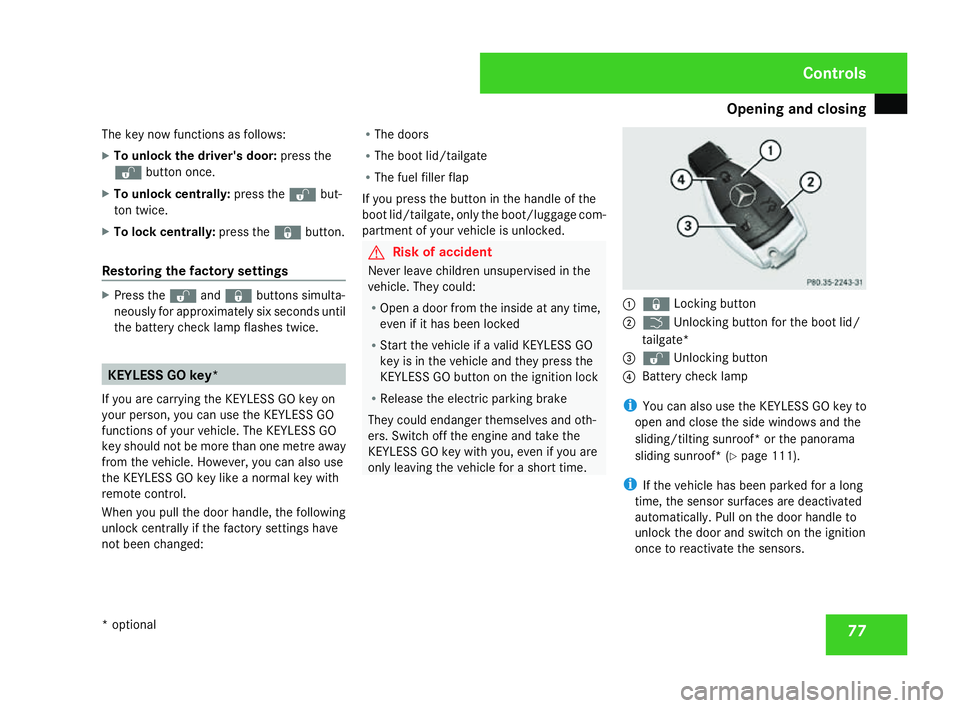
Opening and closing
77
The key now functions as follows:
X
To unlock the driver's door: press the
k button once.
X To unlock centrally :press the kbut-
ton twice.
X To lock centrally :press the jbutton.
Restoring the factory settings X
Press the kandj buttons simulta-
neously for approximately six seconds until
the battery check lamp flashes twice. KEYLESS GO key*
If you are carrying the KEYLESS GO key on
your person, you can use the KEYLESS GO
functions of your vehicle. The KEYLESS GO
key should not be more than one metre away
from the vehicle. However, you can also use
the KEYLESS GO key like a normal key with
remote control.
When you pull the door handle, the following
unlock centrally if the factory settings have
not been changed: R
The doors
R The boot lid/tailgate
R The fuel filler flap
If you press the button in the handle of the
boot lid/tailgate, only the boot/luggage com-
partment of your vehicle is unlocked. G
Risk of accident
Never leave children unsupervised in the
vehicle. They could :
R Open a door from the inside at any time,
even if it has been locked
R Start the vehicle if a valid KEYLESS GO
key is in the vehicle and they press the
KEYLESS GO button on the ignition lock
R Release the electric parking brak e
They could endanger themselves and oth-
ers. Switch off the engine and take the
KEYLESS GO key with you, even if you are
only leaving the vehicle for a short time. 1
j Locking button
2 i Unlocking button for the boot lid/
tailgate*
3 k Unlocking button
4 Battery check lamp
i You can also use the KEYLESS GO key to
open and close the side windows and the
sliding/tilting sunroof* or the panorama
sliding sunroof* (Y page 111).
i If the vehicle has been parked for a long
time, the sensor surfaces are deactivated
automatically. Pull on the door handle to
unlock the door and switch on the ignition
once to reactivate the sensors. Controls
* optional
204_AKB; 2; 3, en-GB
mkalafa
, 2007-06-26T23:11:51+02:00 - Seite 77
Page 81 of 377
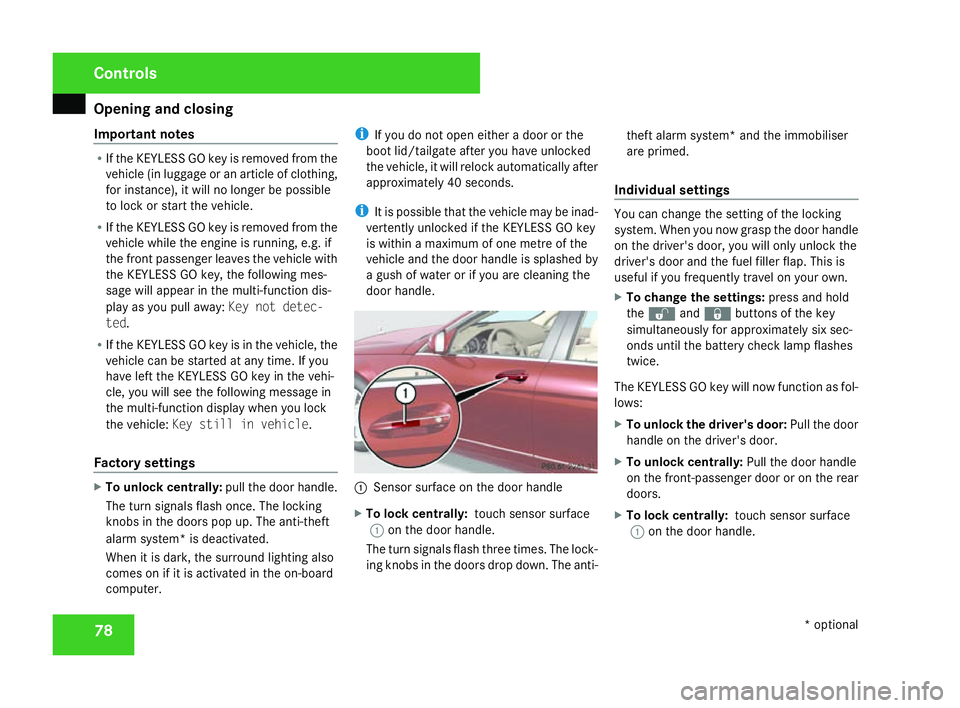
Opening and closing
78
Important notes R
If the KEYLESS GO key is removed from the
vehicle (in luggage or an article of clothing,
for instance), it will no longer be possible
to lock or start the vehicle .
R If the KEYLESS GO key is removed from the
vehicle while the engine is running, e.g. if
the front passenger leaves the vehicle with
the KEYLESS GO key, the following mes-
sage will appear in the multi-function dis-
play as you pull away: Key not detec-
ted.
R If the KEYLESS GO key is in the vehicle, the
vehicle can be started at any time. If you
have left the KEYLESS GO key in the vehi-
cle, you will see the following message in
the multi-function display when you lock
the vehicle: Key still in vehicle.
Factory settings X
To unlock centrally :pull the door handle.
The turn signals flash once. The locking
knobs in the doors pop up. The anti-thef t
alarm system* is deactivated.
When it is dark, the surround lighting also
comes on if it is activated in the on-board
computer. i
If you do not open either a door or the
boot lid/tailgate after you have unlocked
the vehicle, it will relock automatically after
approximately 40 seconds.
i It is possible that the vehicle may be inad-
vertently unlocked if the KEYLESS GO key
is within a maximum of one metre of the
vehicle and the door handle is splashed by
a gush of water or if you are cleaning the
door handle . 1
Sensor surface on the door handl e
X To lock centrally: touch sensor surface
1 on the door handle.
The turn signals flash three times. The lock-
ing knobs in the doors drop down. The anti- theft alarm system* and the immobiliser
are primed.
Individual settings You can change the setting of the lockin
g
system. When you now grasp the door handle
on the driver's door, you will only unlock the
driver's door and the fuel filler flap. This is
useful if you frequently travel on your own.
X To change the settings :press and hold
the k andj buttons of the key
simultaneously for approximately six sec-
onds until the battery check lamp flashes
twice.
The KEYLESS GO key will now function as fol-
lows:
X To unlock the driver's door: Pull the door
handle on the driver's door.
X To unlock centrally :Pull the door handle
on the front-passenger door or on the rear
doors.
X To lock centrally: touch sensor surface
1 on the door handle. Controls
* optional
204_AKB; 2; 3, en-GB
mkalafa,
2007-06-26T23:11:51+02:00 - Seite 78
Page 101 of 377

Seat belts
98
X
Make sure that the vehicle is stationary and
that the key is in position 2in the ignition
lock .
X Press button 2for the exterior mirror on
the front-passenger side .
X Use adjustment button 3to adjust the
exterior mirror to a position which allows
you to see the rear wheel and the kerb .
X Press memory button M4 .
X Press one of the arrows on adjustment but-
ton 3within three seconds.
The parking position is stored if the exterior
mirror does not move.
i If the mirror moves out of position, repeat
the steps. You can adjust the exterior mir-
ror again after storing the setting . Seat belts
Seat belts are the most effective means of
restraining the movement of vehicle occu-
pants in the event of an accident. This
reduces the risk of vehicle occupants coming
into contact with the vehicle interior. Wearing seat belts
G
Risk of injury
A seat belt which is not worn correctly, or
which has not been engaged in the seat bel t
buckle correctly, cannot perform its inten-
ded protective function. Under certain cir-
cumstances this could cause severe or
even fatal injuries.
Make sure that all occupants – in particular,
pregnant women – wear their seat belt cor-
rectly at all times .
R The seat belt must pass closely over your
body and must not be twisted. You
should therefore avoid wearing bulky
clothing (e.g. a winter coat). The shoulder
belt section must be routed across the
middle of your shoulder – on no account
across your neck or under your arm – and
pulled tight against your upper body. The
lap belt must always pass across your lap as low down as possible, i.e. over your
hip joints – not across your abdomen. If
necessary, tighten the belt strap by pull-
ing it down slightly and retighten in the
direction of the inertia reel.
R Do not route the belt strap across sharp
or fragile objects, especially if these ar e
located on or in your clothing, e.g. spec -
tacles, pencils, keys, etc. The seat belt
strap could be damaged and tear in an
accident and you or other vehicle occu -
pants could be injured.
R Only one person should use each seat
belt at any one time. On no account
should children travel sitting on your lap
or the lap of another occupant, as it
would not be possible to restrain the
child in the event of an accident, braking
or a sudden change in direction, which
could result in severe or even fatal inju-
ries to the child and other occupants.
R Persons less than 1.50 m tall cannot
wear the seat belts correctly. For this
reason, secure persons less than 1.50 m
tall in specially designed, suitabl e
restraint systems .
R Children less than 1.50 m tall or under
12 years of age cannot wear the seat Control
s
204_AKB; 2; 3, en-GB
mkalafa,
2007-06-26T23:11:51+02:00 - Seite 98
Page 105 of 377
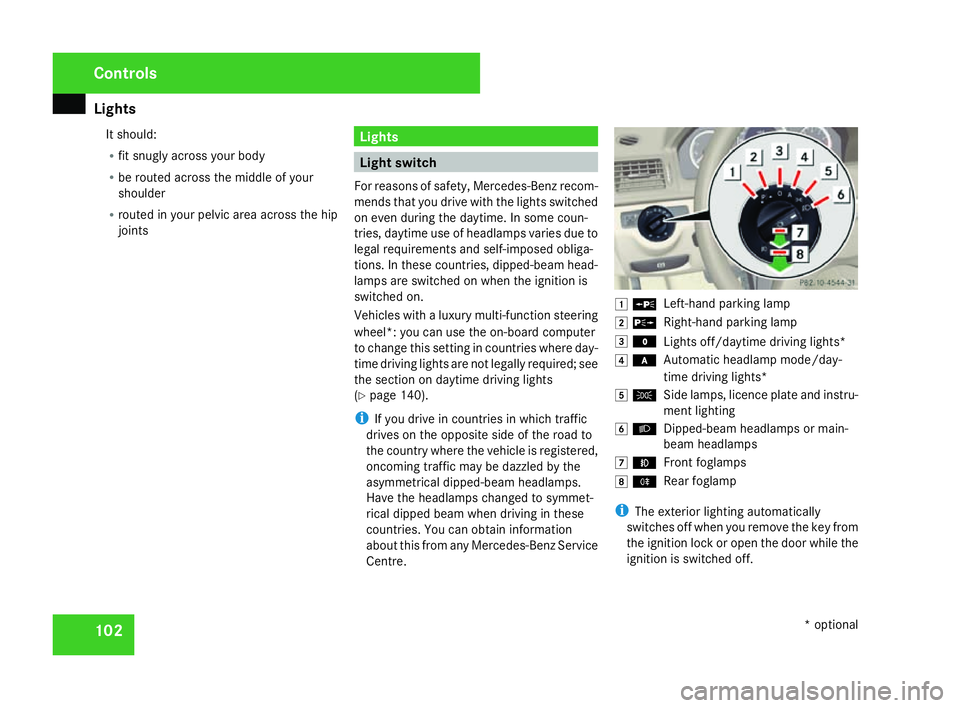
Light
s 102It should:
R
fit snugly across your body
R be routed across the middle of your
shoulder
R routed in your pelvic area across the hip
joints Lights
Light switch
For reasons of safety, Mercedes-Benz recom-
mends that you drive with the lights switched
on even during the daytime. In some coun-
tries, daytime use of headlamps varies due to
legal requirements and self-imposed obliga-
tions. In these countries, dipped-beam head-
lamps are switched on when the ignition is
switched on.
Vehicles with a luxury multi-function steering
wheel*: you can use the on-board computer
to change this setting in countries where day-
time driving lights are not legally required; se e
the section on daytime driving lights
( Y page 140).
i If you drive in countries in which traffic
drives on the opposite side of the road to
the country where the vehicle is registered ,
oncoming traffic may be dazzled by the
asymmetrical dipped-beam headlamps.
Have the headlamps changed to symmet-
rical dipped beam when driving in these
countries. You can obtain information
about this from any Mercedes-Benz Servic e
Centre. $
a
Left-hand parking lamp
% g
Right-hand parking lamp
& M
Lights off/daytime driving lights*
( *
Automatic headlamp mode/day -
time driving lights*
) C
Side lamps, licence plate and instru-
ment lighting
* B
Dipped-beam headlamps or main-
beam headlamps
, ¥
Front foglamp s
. †
Rear foglamp
i The exterior lighting automatically
switches off when you remove the key from
the ignition lock or open the door while the
ignition is switched off. Controls
* optional
204_AKB; 2; 3, en-GB
mkalafa,
2007-06-26T23:11:51+02:00 - Seite 102
Page 107 of 377
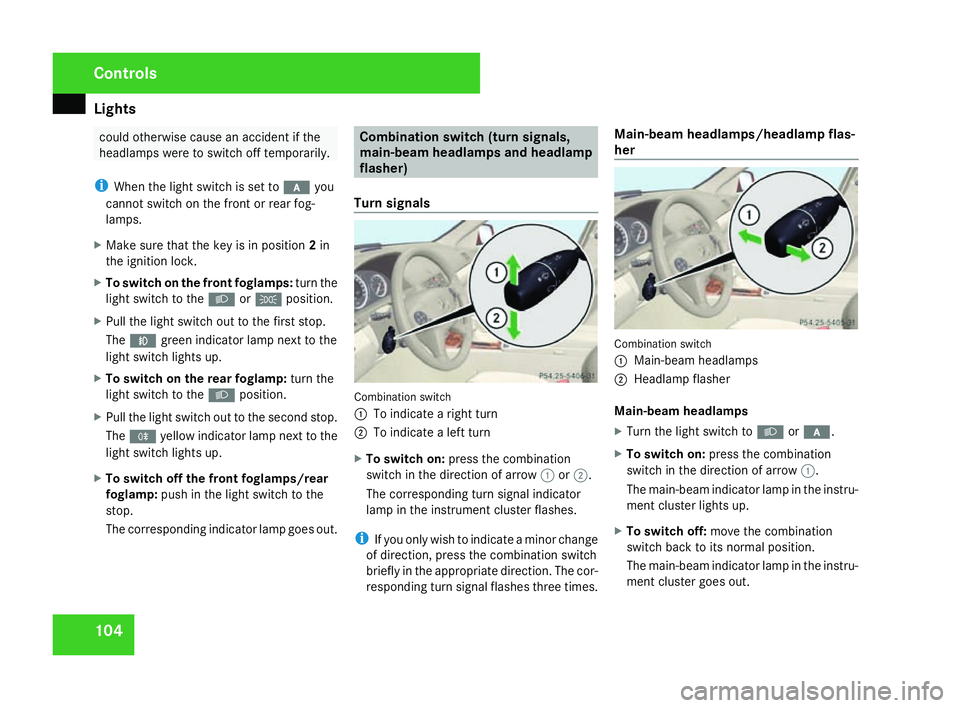
Light
s 104 could otherwise cause an accident if the
headlamps were to switch off temporarily.
i When the light switch is set to *you
cannot switch on the front or rear fog-
lamps.
X Make sure that the key is in position 2in
the ignition lock .
X To switch on the front foglamps: turn the
light switch to the BorC position .
X Pull the light switch out to the first stop.
The ¥ green indicator lamp next to the
light switch lights up.
X To switch on the rear foglamp: turn the
light switch to the Bposition .
X Pull the light switch out to the second stop.
The † yellow indicator lamp next to th e
light switch lights up.
X To switch off the front foglamps/rear
foglamp: push in the light switch to the
stop .
The corresponding indicator lamp goes out. Combination switch (turn signals,
main-beam headlamps and headlam
p
flasher)
Turn signals Combination switch
1 To indicate a right turn
2 To indicate a left turn
X To switch on :press the combination
switch in the direction of arrow 1or2 .
The corresponding turn signal indicator
lamp in the instrument cluster flashes.
i If you only wish to indicate a minor change
of direction, press the combination switch
briefly in the appropriate direction. The cor-
responding turn signal flashes three times. Main-beam headlamps/headlamp flas-
her
Combination switch
1
Main-beam headlamps
2 Headlamp flasher
Main-beam headlamps
X Turn the light switch to Bor* .
X To switch on: press the combinatio n
switch in the direction of arrow 1.
The main-beam indicator lamp in the instru-
ment cluster lights up.
X To switch off: move the combinatio n
switch back to its normal position.
The main-beam indicator lamp in the instru-
ment cluster goes out. Controls
204_AKB; 2; 3, en-GB
mkalafa,
2007-06-26T23:11:51+02:00 - Seite 104
Page 109 of 377
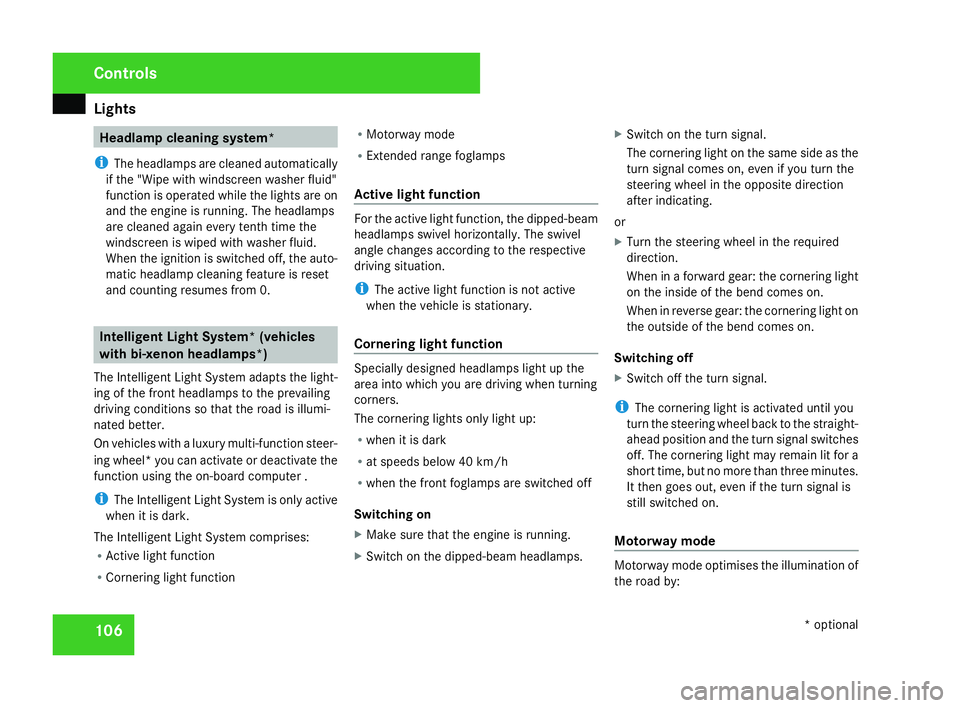
Light
s 106 Headlamp cleaning system*
i The headlamps are cleaned automatically
if the "Wipe with windscreen washer fluid"
function is operated while the lights are on
and the engine is running. The headlamps
are cleaned again every tenth time the
windscreen is wiped with washer fluid.
When the ignition is switched off, the auto-
matic headlamp cleaning feature is reset
and counting resumes from 0. Intelligent Light System* (vehicles
with bi-xenon headlamps*)
The Intelligent Light System adapts the light-
ing of the front headlamps to the prevailing
driving conditions so that the road is illumi-
nated better .
On vehicles with a luxury multi-function steer-
ing wheel* you can activate or deactivate the
function using the on-board computer .
i The Intelligent Light System is only active
when it is dark.
The Intelligent Light System comprises:
R Active light functio n
R Cornering light function R
Motorway mode
R Extended range foglamps
Active light function For the active light function, the dipped-beam
headlamps swivel horizontally. The swivel
angle changes according to the respectiv
e
driving situation .
i The active light function is not active
when the vehicle is stationary.
Cornering light function Specially designed headlamps light up the
area into which you are driving when turnin
g
corners.
The cornering lights only light up :
R when it is dark
R at speeds below 40 km/h
R when the front foglamps are switched off
Switching on
X Make sure that the engine is running.
X Switch on the dipped-beam headlamps. X
Switch on the turn signal .
The cornering light on the same side as the
turn signal comes on, even if you turn the
steering wheel in the opposite direction
after indicating.
or
X Turn the steering wheel in the required
direction .
When in a forward gear: the cornering light
on the inside of the bend comes on.
When in reverse gear: the cornering light on
the outside of the bend comes on.
Switching off
X Switch off the turn signal .
i The cornering light is activated until you
turn the steering wheel back to the straight -
ahead position and the turn signal switches
off. The cornering light may remain lit for a
short time, but no more than three minutes.
It then goes out, even if the turn signal is
still switched on.
Motorway mode Motorway mode optimises the illumination of
the road by:Controls
* optional
204_AKB; 2; 3, en-GB
mkalafa,
2007-06-26T23:11:51+02:00 - Seite 106